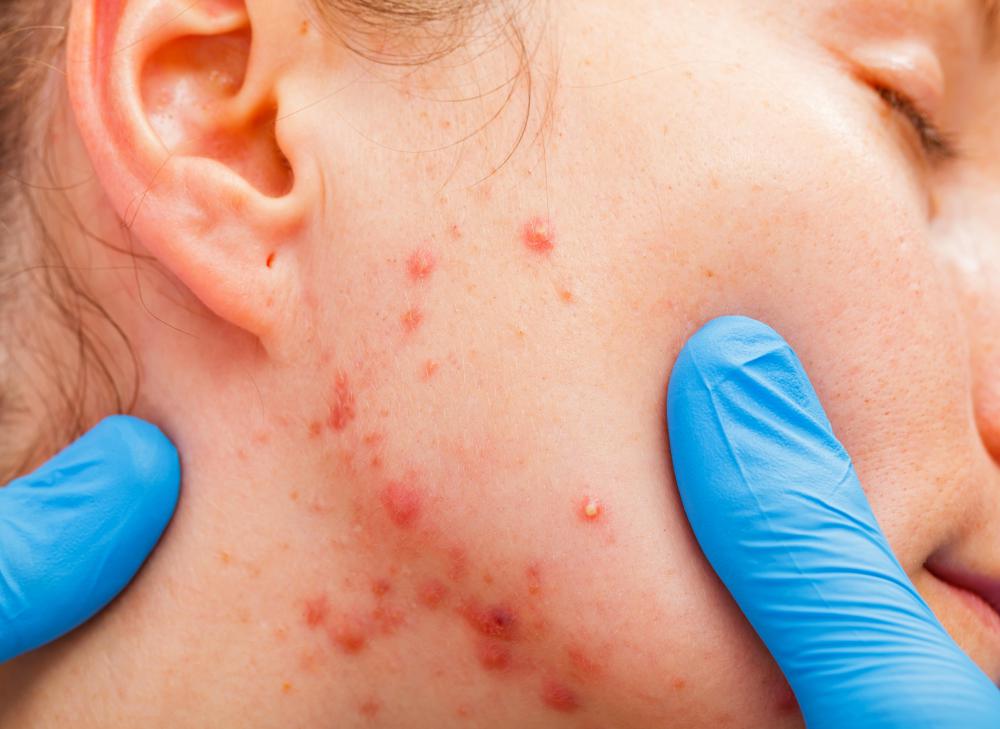At WiseGEEK, we're committed to delivering accurate, trustworthy information. Our expert-authored content is rigorously fact-checked and sourced from credible authorities. Discover how we uphold the highest standards in providing you with reliable knowledge.
What Is the Difference between Tretinoin and Clindamycin?
Though used for some similar purposes, the main difference between tretinoin and clindamycin is the drug classification of each medication. Tretinoin is considered a retinoid, which describes a group of vitamin A derivatives. Unlike tretinoin, clindamycin is classified as an antibiotic, and is generally used in topical form.
Generally speaking, both medications are routinely used for the treatment of acne. Each medication treats acne differently, however. For example, topical tretinoin fights acne by penetrating the skin and loosening clogged pores, while clindamycin targets and kills acne-causing bacteria. In some cases, both of the medications are used in tandem due to their complementary acne-fighting mechanisms.

In addition to treating acne, tretinoin and clindamycin can also treat other types of health conditions. Tretinoin has been known to reduce the appearance of fine wrinkles, dark sports and sun-damaged skin. Besides using the retinoid for cosmetic purposes, tretinoin can be used to treat other skin disorders such as keratosis follicularis and verruca plana. Keratosis follicularis is characterized by small red bumps, while verruca plana are flat warts.

Other uses of clindamycin are varied. It is sometimes used to treat serious bacterial infections, as well as bone, respiratory tract and soft tissue infections. Clindamycin will kill most gram-positive or gram-negative bacterial infections such as Staphylococcus and Prevotella. This antibiotic comes in many forms including oral, gel and suppository.

Despite the benefits these medications have, both tretinoin and clindamycin have different side effects depending on various factors. Side effects for tretinoin are generally skin-related, considering the drug only comes in a topical form, and usually lessen or disappear after the first few applications. Many who use the retinoid experience mild skin irritation including redness, dryness and even slight peeling. Others experience burning, stinging or tingling of the skin upon the first application. Serious reactions are rare, but might include severe allergic reaction, unusual bleeding or a heart attack while taking the medication.

Common side effects for clindamycin in oral form include diarrhea, nausea and abdominal discomfort. When administered in topical form, the most common skin reactions are dryness, itching or slight stinging at the application site. Much like tretinoin, all forms of clindamycin can produce severe side effects, such as bloody stool, dark urine or jaundice. People with certain kidney or stomach conditions, or severe allergies should discuss the risks versus the benefits with a medical professional before taking this medication.
Price is another area where tretinoin and clindamycin differ. Generally speaking, tretinoin is more expensive than topical clindamycin. Both medications are available in generic or brand name versions.
AS FEATURED ON:
AS FEATURED ON:



















Discussion Comments
I'm using tretinoin and clindamycin for acne as well. I'm not sure which is the culprit, but I have irritated, dry, itchy and peeling skin since I started using them together.
@fBoyle-- My dermatologist gave me a gel for my acne that has these two medications in it. The tretinoin is .025% and the clindamycin is 1.2%. I've been using the gel for a few months now and it's definitely helping. I've noticed that I have less breakouts and the pimples are not as large as before.
I don't think that tretinoin and clindamycin are used together in any other way for acne. Your dermatologist will give you this gel medication, you won't be given clindamycin tablets.
I don't know if it's bad to use antibiotics for a long time but I've heard that there are people who have used this gel for a year or more. I don't think that the clindamycin in the gel is harmful because it's not a high dose. Plus, I only use a pea sized amount once a day, before I go to bed.
You're better off asking your dermatologist these questions though. I might be wrong.
When tretinoin and clindamycin are used at the same time for acne, is the tretinoin used as cream and clindamycin as tablet medication?
I know that tretinoin can be used for a long time for acne, but what about clindamycin? It's not good to use antibiotics for a long time right?
Post your comments